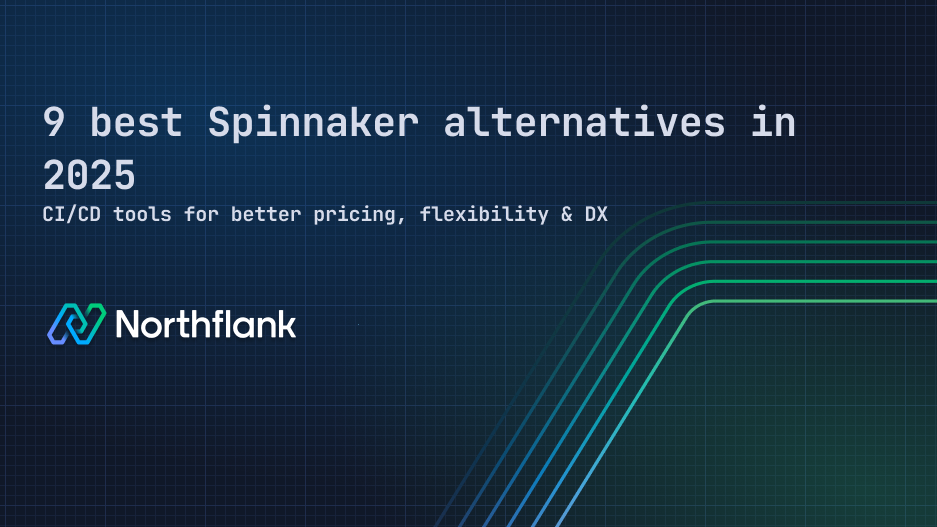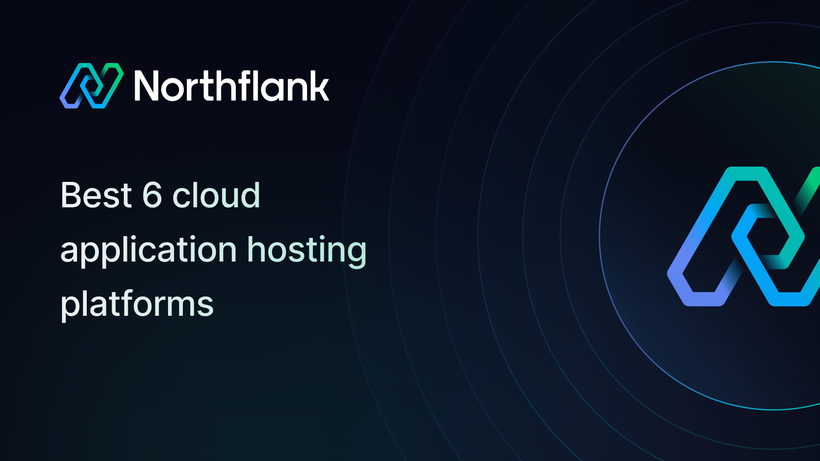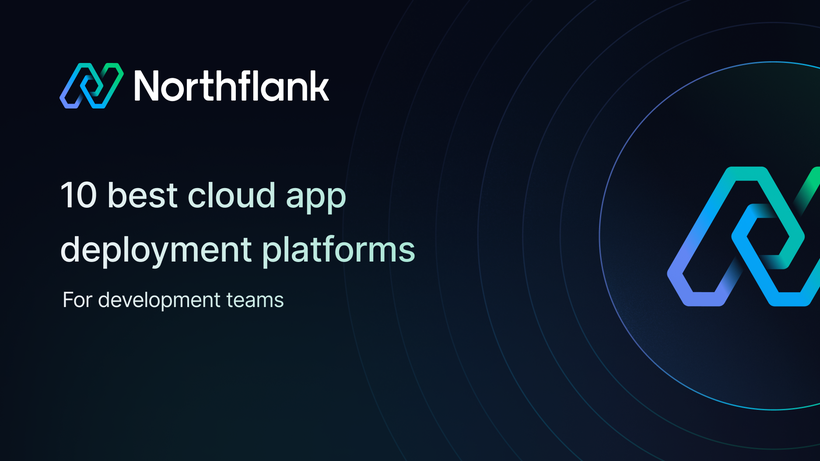

9 best Spinnaker alternatives in 2025: CI/CD tools for better pricing, flexibility & DX
Spinnaker alternatives have been a hot topic lately, and for good reason. For a while now, I’ve seen developers complain about Spinnaker’s complexity and how much effort it takes to keep things running.
Some developers expressed their frustration about these issues on Reddit. They talked about maintenance-heavy setups, limited GitOps support, and the lack of flexibility. A few mentioned switching to alternatives like ArgoCD, tools they consider easier to manage and more aligned with modern DevOps practices.
Do you have similar complaints, or just looking for a Spinnaker alternative? If yes, then this article is for you.
We’ll look at 9 Spinnaker alternatives that are easier to deploy, maintain, and work with, and in many cases, much more budget-friendly than keeping Spinnaker running.
In a hurry? Here's a quick breakdown of some of the best Spinnaker alternatives for 2025:
- Northflank – Full GitOps support, built-in logs & metrics, BYOC, and background jobs.
- Argo CD – Kubernetes-native GitOps tool with declarative delivery.
- Jenkins – Long-standing CI tool that pairs with CD solutions.
- Azure DevOps – Microsoft-native CI/CD pipelines with tight Azure integration.
- Harness – Enterprise-grade CD with machine learning-based verification.
- Qovery – Git-based deployment platform with strong developer UX.
- GitHub Actions – Built-in CI/CD for GitHub repositories.
- OpenShift Pipelines – Tekton-powered pipelines for K8s-heavy teams.
- Fly.io – Fast deploys with regional app hosting and Git-based flow.
Before we get into the details, here’s a quick comparison of how each tool compares across the basics.
We’re looking at four things that tend to matter most when teams like yours are moving away from Spinnaker:
- GitOps support
- Built-in observability (logs, metrics, debugging)
- CI/CD coverage (do you need to plug in other tools?)
- Pricing model (because not everyone has the budget for enterprise licenses)
Look at the comparison:
| Platform | GitOps | Observability | CI/CD Coverage | Pricing Model / Starting Price |
|---|---|---|---|---|
| Northflank | Yes | Full logs & metrics | Full CD, background jobs | Free plan + usage-based (BYOC supported) |
| Argo CD | Yes | K8s-native only | CD only | Free (open-source) |
| Jenkins | No | Manual | CI only | Free (open-source) |
| Azure DevOps | Partial | Basic built-in | Full CI/CD | Free for 5 users, then $6/user/month |
| Harness | Yes | ML-based metrics | Full CI/CD | Paid only (contact sales) |
| Qovery | Yes | Git-based deploy logs | CD only | Free for hobby, from $49/month |
| GitHub Actions | Yes | Lightweight | Full CI/CD | Free up to 2k minutes, then pay-as-you-go |
| OpenShift Pipelines | Yes | K8s-native observability | CD | Included with OpenShift |
| Fly.io | No | Runtime & app logs | CD for small apps | Free tier + usage-based |
If you’re thinking of switching from Spinnaker, it helps to know what to prioritize before picking a replacement.
For most teams like yours, it’s not just about finding another CI/CD tool. It’s about making sure you’re not spending hours managing infrastructure or piecing together several different tools just to ship code.
Let’s see the few things that are worth paying attention to as you look for a better fit.

Tools that use Git as the source of truth help reduce manual steps and make your deployments more predictable and auditable. It’s a bonus if the tool supports Helm, Kustomize, or other Kubernetes-native config tools.
Look for platforms that give you logs, metrics, deployment history, and rollback options without needing third-party integrations. That alone saves hours of debugging and setup time.
Some platforms handle both CI and CD. Others focus on CD and expect you to bring your own CI. Either is fine, what matters is “does it fit your workflow or make you add complexity?”
Native secrets support is ideal, but it’s also fine if it integrates cleanly with Vault of Kubernetes secrets. What you don’t want is a setup where secrets are treated like an afterthought.
Not every app is a web service. If you rely on background workers, corn jobs, or task queues, make sure the platform supports those too, or gives you a way to manage them alongside services.
If the tools need a full-time DevOps engineer just to get it running (looking at you, Spinnaker), it might not be the right long-term fit. Look for something that’s easier to adopt and doesn’t fight your team.
Some tools are open-source. Others, like Northflank, give you usage-based pricing or bring-your-own-cloud options. So, depending on your needs, one model might make a lot more sense than the other, especially if you’re trying to reduce costs or avoid vendor-lock-in.
We’ve covered the basics, now let’s look at each platform in a bit more detail.
If you’re here, you’re most likely trying to move away from Spinnaker without making things harder for your team. It could be one of the following reasons:
- You want a GitOps-friendly setup
- You’re done dealing with the stress that comes with on-prem
- You want something that’s easier to manage and works out of the box
Whatever the case, I’ve broken down these 9 Spinnaker alternatives by how they work, where they fit best, and why teams are switching to them.
Let’s start with Northflank.
If you’re looking for something that’s GitOps-friendly out of the box, has great built-in observability, and doesn’t require combining multiple tools like Prometheus for metrics, Loki for logs, or custom dashboards for deployment history, Northflank might be exactly what you need.
It supports:
- Full CD pipelines
- Background jobs
- Build services
- BYOC (Bring Your Own Cloud) features
- … and more
It lets you bring your own cloud if that’s your setup. This means you can deploy workloads into your AWS or GCP account while using Northflank’s interface, monitoring, and deployment controls.

Also, with Northflank, you get logs, metrics, and deployment history directly in the platform, so you don’t have to integrate separate services or write extra config just to see what’s going on.
Northflank also gives you flexibility around how you deploy. You can:
- Push from Git (See how)
- Build from Dockerfiles (See how)
- Spin up preview environments (See how)
- Manage services (See how)
- Cron jobs (See how)
- Storage (See how)
The good part is that you can do all these in one place!
And if you’re working with a team, it’s easy to assign access, manage secrets, and define custom roles without needing to dig into complex RBAC setups.
If Spinnaker has started to feel too rigid or time-consuming for your use case, Northflank gives you a simpler and more maintainable path forward.
See Northflank in action or book a live demo to see how it compares.
If your team is already running workloads on Kubernetes and you want a GitOps tool purpose-built for it, ArgoCD is a good option. It’s fully open source, backed by the CNCF, and widely adopted by teams that are serious about declaratively managing Kubernetes.
With ArgoCD, your Git repo becomes your application state's single source of truth. It watches for changes in your manifests and automatically syncs them to your Kubernetes cluster. That means you get automated, version-controlled deployments using YAML or Helm (no need to trigger deploys manually or update config across different tools).

Some of the key features include:
- Declarative GitOps deployments for Kubernetes
- Support for Helm, Kustomize, Jsonnet, and plain YAML
- Multiple cluster support
- Application health status monitoring
- Sync and rollback controls
It’s worth noting that Argo CD doesn’t include CI capabilities, so you’ll need to pair it with a CI tool like GitHub Actions, CircleCI, or Northflank if you want a full pipeline from code to deploy.
Also, Argo doesn’t come with built-in secrets management. You can integrate it with tools like HashiCorp Vault or Sealed Secrets, but you’ll need to handle that setup yourself.
That said, if you’re comfortable with Kubernetes and want a lightweight GitOps CD engine that fits cleanly into your workflow, Argo CD is definitely worth looking into.
You can check out Argo CD’s documentation or try it on GitHub to get started.
If you're also looking into tools that improve on what Argo does (or fill in the gaps), check out this Argo CD alternatives guide.
Jenkins is one of the oldest and most widely used CI tools out there. If you've ever built a pipeline before, chances are you've used Jenkins at some point. It’s open source, heavily extensible, and still used in a lot of production systems today.
That said, Jenkins on its own is more of a CI tool than a full CD platform. It doesn’t have built-in deployment tracking, rollback support, or native GitOps functionality, so if you’re thinking about replacing Spinnaker with Jenkins alone, you’ll likely need to add a few more tools to your stack.

You can still make it work for CD, especially if you're comfortable managing plugins and custom scripts. Jenkins has a massive plugin ecosystem that lets you hook into most services and cloud providers, and some teams use it for end-to-end automation. But the tradeoff is the amount of maintenance involved. You’ll spend time upgrading plugins, dealing with UI limitations, and handling user management manually unless you build your own solutions around it.
Some key things to keep in mind:
- Reliable CI capabilities
- Flexible, with hundreds of plugins
- Can be extended for CD, but not out of the box
- You’ll need to configure observability, RBAC, secrets, and rollback manually
If your use case is mostly CI or you're inheriting an existing Jenkins setup, it can still get the job done. But for modern, Git-based CD workflows with better built-in controls, you might want to pair Jenkins with another tool, or go for something that handles CI/CD together.
You can read more in this Jenkins alternatives guide if you're looking to move on from it completely.
If your team is already deep into Azure or using tools like Visual Studio and Git repos hosted on Azure, then Azure DevOps might already be part of your stack. It’s Microsoft’s full DevOps suite, covering everything from code repos and CI/CD pipelines to project boards and test plans.
The CI/CD part comes from Azure Pipelines, which supports both YAML-based and classic GUI pipelines. You can use it to build, test, and deploy to Azure, AWS, on-prem servers, or Kubernetes clusters. It’s flexible, and it integrates well with Microsoft tools out of the box.

That said, it can feel a bit clunky if you’re not fully bought into the Azure ecosystem. There’s a decent amount of setup required to get pipelines running, and you’ll likely be writing more YAML than you’d expect. GitOps support is also limited; it's there, but mostly for pipelines, not releases, so if you're looking for something closer to Argo CD or Northflank, this might feel like a step back.
Here’s what stands out:
- CI/CD pipelines with support for YAML and classic editors
- Built-in Git repos, boards, and test plans
- Good integration with Azure and other Microsoft tools
- Works with self-hosted agents or Microsoft-hosted runners
- Some GitOps workflows possible, but not full support
- Secrets management, RBAC, and approval flows are built in, but often need configuration
If you’re already using Azure DevOps, it might make sense to keep building on top of it. But if you’re starting from scratch or want something more developer-friendly with less overhead, there are definitely lighter and more flexible tools out there.
And if you’re weighing it up against platforms that support GitOps and modern workflows better, this Azure alternatives guide might help.
If you’re looking for a more polished, enterprise-ready take on Continuous Delivery, Harness is worth checking out. It was created by the same co-founder of AppDynamics, and it’s positioned as a commercial alternative to Spinnaker, with a bigger focus on usability and automation.
Harness supports things like canary deployments, automated rollbacks, approval workflows, and continuous verification. It also has its own CI engine, but where it really leans in is CD. You get granular control over pipelines, built-in RBAC, and integrations with tools like Datadog, New Relic, and Prometheus for monitoring deployments.

One feature Harness is known for is automated verification (basically using ML to compare pre-deploy and post-deploy metrics to help catch issues early). It’s designed for teams that want to move fast but still keep quality and compliance in check.
Here’s what stands out:
- CD pipelines with rollback, canary, and blue/green support
- Machine learning-based deployment verification
- Secrets management, audit trails, and fine-grained access controls
- Built-in CI and feature flagging modules if you need them
- Works with Kubernetes, VMs, AWS, GCP, and Azure
- SaaS and on-prem options available
The main downside? It’s not cheap. There’s no free tier, and pricing is usage-based with custom quotes. You can request a trial, but it’s clearly targeted at mid-to-large teams with serious deployment volume and strict security needs.
If you’re replacing Spinnaker in an enterprise setting and want support, governance, and automation out of the box, Harness is a good option to look into.
You can read more in this Harness alternatives guide if you’re weighing it against other tools.
If you want a platform that takes care of infrastructure without getting in your way, Qovery might be a good fit. It’s a deployment platform built for developers, especially teams that want to ship from Git without managing Kubernetes directly.
Qovery sits somewhere between a PaaS and a control plane. You connect your Git repo, configure your environment, and Qovery handles provisioning, deployment, and environment management. Under the hood, it’s running on Kubernetes, but you don’t need to touch YAML unless you want to.

It supports multi-service apps, preview environments, secrets management, and even cron jobs. You can choose between running on Qovery’s cloud or in your own AWS account, which gives you flexibility depending on your team’s needs.
Here’s what stands out:
- Preview environments for every pull request
- Secrets and config management built in
- Support for background jobs and cron scheduling
- Can be hosted on Qovery’s cloud or self-managed on AWS
- Docker and Kubernetes support under the hood, but abstracted away by default
Qovery doesn’t aim to replace every enterprise use case, but for developers who want to focus on writing and shipping code, without stitching together a full CI/CD pipeline.
If you're comparing platforms in this category, this Qovery alternatives guide might help you see how it stacks up.
If your code already lives on GitHub, GitHub Actions is one of the easiest ways to start building and deploying your projects. It’s fully integrated into the GitHub UI, supports event-driven workflows, and can be used for everything from linting and testing to full application deployments.
You define your pipelines as YAML files inside your repo, and Actions takes care of the rest, including triggering workflows on every push, PR, or tag. You can deploy to Kubernetes, AWS, GCP, Azure, or even self-hosted servers, depending on how you set it up.

It’s not a full platform like Spinnaker, but with the right actions and integrations, you can build powerful pipelines without leaving your repo.
What stands out:
- Tight GitHub integration with event-based triggers
- Huge marketplace of pre-built actions to deploy to any cloud or service
- Simple syntax and quick setup for small teams
- Works well for CI/CD, infrastructure automation, or custom workflows
- Pay-as-you-go pricing with a generous free tier (2,000 minutes/month for public repos)
GitHub Actions is especially useful for smaller teams, hobby projects, or startups that want to keep things simple. It scales pretty well, but for large-scale delivery pipelines with approval flows, GitOps, or security policies, you might need to combine it with another tool.
Still, if you’re already using GitHub, it’s one of the most convenient places to start.
You can also check out this GitHub Actions alternatives guide if you're thinking about building more complex workflows or want more control.
If you're working in a Red Hat environment or already using OpenShift, OpenShift Pipelines might be a natural fit. It's Red Hat’s CI/CD solution built on top of Tekton, which is an open-source framework for running Kubernetes-native pipelines.
OpenShift Pipelines lets you define tasks and pipelines as Kubernetes custom resources. It integrates with your cluster’s RBAC, supports triggers, and gives you full control over how your builds and deployments run, all in a declarative, container-native way.

Unlike platforms like Spinnaker, OpenShift Pipelines is built for teams that are already deep in Kubernetes and want pipelines that behave like any other workload in their cluster.
Here’s what stands out:
- Built on Tekton, a CNCF project for Kubernetes-native pipelines
- Integrated with OpenShift’s developer console and RBAC model
- Declarative workflows defined as Kubernetes CRDs
- Pipeline triggers for event-based CI/CD
- Can deploy to any Kubernetes target within your cluster
- Ideal for GitOps and Git-based deployments when paired with Argo CD
That said, it’s not the most beginner-friendly option. You’ll need to be comfortable working inside Kubernetes and managing pipelines as code. But if that’s your setup already, OpenShift Pipelines gives you a powerful, consistent way to build and deploy within your platform.
You can get started in the OpenShift Pipelines docs or check other Kubernetes platform alternatives if you're looking for something lighter.
Fly.io is built for developers who want to deploy apps close to their users, without getting into Kubernetes or managing cloud infrastructure. You write your app, run a simple CLI command, and Fly handles the rest: provisioning, networking, certificates, scaling, and regional deploys.
It’s especially popular for full-stack apps that need fast cold starts, edge presence, or region-aware deployment logic. You can run databases, background jobs, and even scale apps across multiple regions with relatively little setup.

Here’s what makes Fly.io stand out:
- Global app hosting with regional scaling
- Simple deploys from Docker or buildpacks
- Support for Postgres, Redis, and other managed services
- Secrets management and app metrics included
- Free tier available, with usage-based billing after that
Fly.io doesn’t give you the same level of control as something like Spinnaker or Argo CD, no pipeline builders, no complex approval flows. But if you want to ship fast, monitor your apps easily, and deploy globally from the CLI, it’s one of the simplest ways to do it.
You can also check out Fly.io alternatives if you’re looking for more visibility or GitOps support.
If you're still figuring out where Spinnaker fits into the bigger picture or trying to understand how it compares to other tools, this will help. These are some of the most common questions people ask when deciding if they should stick with it or switch to something else.
Spinnaker is an open-source Continuous Delivery platform. It helps teams automate application deployments, especially in multi-cloud environments. It was originally built by Netflix to handle their production rollouts, and it’s known for supporting strategies like blue/green, canary, and rolling deployments.
Yes, Netflix still uses Spinnaker internally. But it's worth noting that many other companies have moved away from it, mostly due to the maintenance effort involved and how hard it can be to scale without a dedicated team.
Spinnaker isn’t exactly lightweight. It requires a complex setup, doesn’t come with built-in secrets management, and isn’t very flexible if you’re trying to follow GitOps workflows. It also doesn’t support SaaS hosting, which makes it harder for teams that just want to deploy without managing infrastructure.
The biggest difference is in the architecture and workflow. Argo CD is GitOps-first and Kubernetes-native; it deploys by syncing your cluster to a Git repo. Spinnaker, on the other hand, takes a more traditional approach to CD with pipelines and custom deploy stages, and it’s not limited to Kubernetes.
Not really. Jenkins is primarily a CI tool, and while it can be extended for CD, it doesn’t come with deployment support out of the box. Spinnaker focuses entirely on CD, you still need to pair it with a CI tool like Jenkins, GitHub Actions, or something else to get a full pipeline.
Spinnaker is still around and used in some enterprise setups, but it’s definitely lost traction in recent years. Many teams are moving to tools that are lighter, easier to manage, and fit better with modern GitOps and Kubernetes workflows.
Spinnaker handles application deployments; it defines how and when apps should roll out. Terraform is an infrastructure-as-code tool that provisions infrastructure, like VMs, databases, or networks. You can use them together (and some teams do), but they solve different problems.
Spinnaker is strictly a CD tool. It doesn’t handle Continuous Integration (like building and testing your code). You’ll need to pair it with a CI tool to get full CI/CD coverage.
By now, you’ve likely seen that there’s no one-size-fits-all answer. Some teams want something that’s GitOps-native and Kubernetes-ready out of the box. Others want a more developer-friendly experience, less manual setup, or a platform that doesn’t require constant maintenance.
Spinnaker can still work for certain use cases, but if maintaining it has started to slow your team down, it might be time to move on. The good news is, you’ve got plenty of options, no matter if you’re looking for something self-hosted, SaaS, simple, or flexible enough to bring your own cloud.
If you're already leaning toward one of the platforms above, the best next step is to try it out in your own workflow and see how it fits. Get started by signing up for free.

